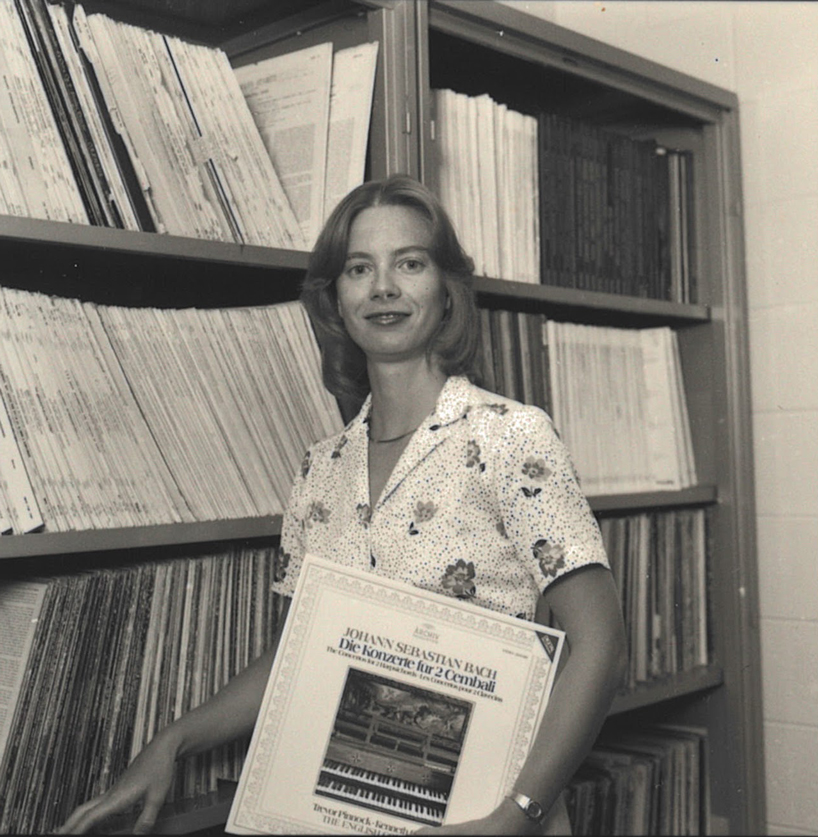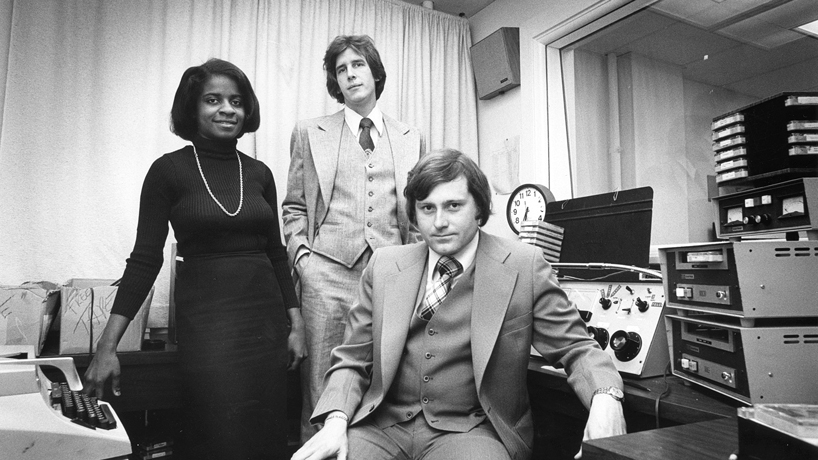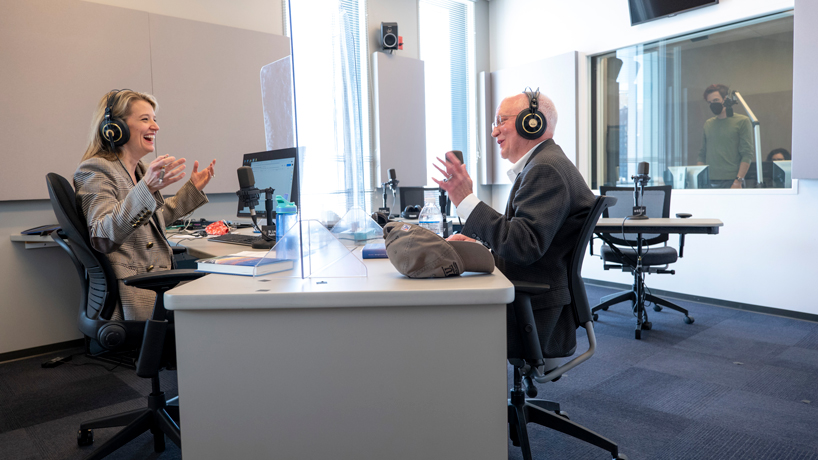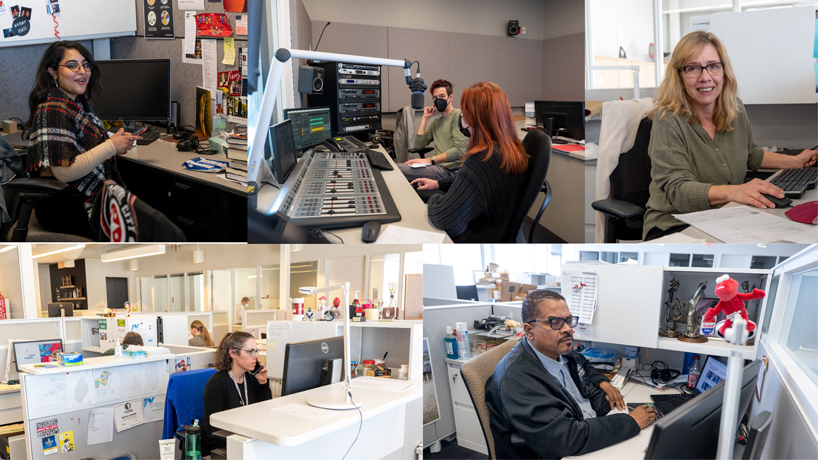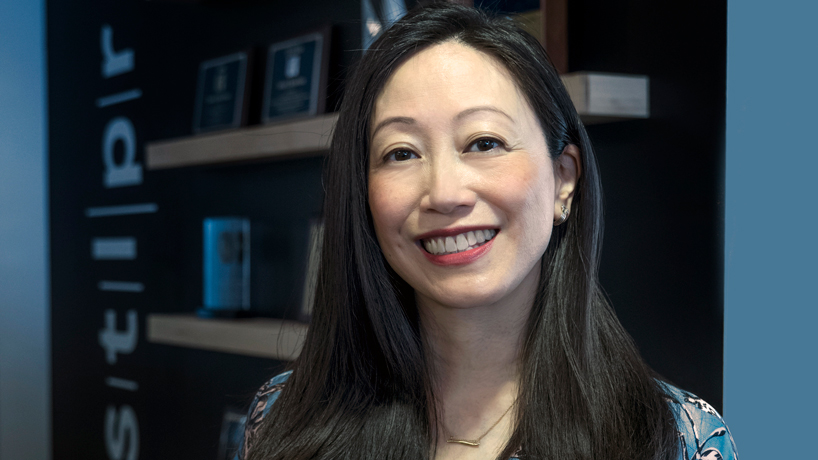
Tina Pamintuan, a 20-year veteran of public media, was hired to serve as St. Louis Public Radio’s CEO last August. She began her position on Dec. 1. (Photo by August Jennewein)
In January 1974, senior Mary Edwards took her first steps into the then-St. Louis Public Radio studios.
In those early days – less than two years after the station signed on air for the first time – they broadcasted from the basement of Lucas Hall on the University of Missouri–St. Louis campus. Locating the National Public Radio affiliate there had been something of an afterthought, so the space had been retrofitted from two classrooms on either side of a hallway.
“Outside of our studio doors, there was a drinking fountain, so there were always students milling about,” Edwards says. “Back then our programming was mostly classical music. We did some jazz on Friday and Saturday night and a limited quantity of news. I think we had an audience of about 30,000.”
Mary Edwards began working at St. Louis Public Radio two years after the station’s founding in 1974. In the early days, much of the station’s programming was classical music. (Archive photo)
The station could hardly have changed more in the subsequent years.
STLPR, which celebrates its 50th anniversary this year, now reaches an audience of more than half-a-million from a gleaming, modern studio in St. Louis’ Grand Center Arts District.
Since its founding, the station has sought to educate and inform the greater St. Louis community, paralleling the university’s vision of providing education for all who seek it and serving as a source of knowledge in the community. It has evolved from mostly music to mostly talk radio in 1996, driven in part by the urgency of reporting during the Gulf War and the popularity of national shows such as “All Things Considered.” The same year, it debuted its popular noon talk show, “St. Louis on the Air.”
A leader in technological innovation, it was the first radio station in the country to broadcast ambisonic programs, the first station in St. Louis to play music from CDs, and was also among the first to move to HD, all-digital transmission.
It has grown substantially in service – adding HD channels focused on jazz and classical music; additional stations in Quincy, Illinois, and Rolla, Missouri; merging with the online news startup the St. Louis Beacon – and consistently collected accolades along the way.
Staff members Deborah Caldwell, Patrick Murphy and Mike Olds gather in the station’s studio in Lucas Hall in the 1970s. (Archive photo)
Socially, STLPR has made strides, notably defeating the Ku Klux Klan in a federal court over the right to decline underwriting support. It launched the podcast “We Live Here” as well as provided award-winning coverage of Michael Brown’s death and its reverberating impact on St. Louis and beyond.
A drive to enhance equity and inclusion within the organization led to the hiring of the station’s new leader, CEO Tina Pamintuan, a 20-year public radio veteran.
Pamintuan, who started her new role Dec. 1, has a bold vision for the future of the station that includes doing the difficult equity work, building capacity, filling a market need for local and breaking news, breaking down walls between digital and radio formats, and growing audiences, especially in digital spaces.
“Fifty years is midlife, which these days is pretty young,” she says. “I feel fortunate to have started at STLPR during this auspicious anniversary. We were right there at the beginning of public media, and that means we’ve grown alongside the big national outlets, but we are deeply engaged in serving the St. Louis community. We’re looking to open up that space to a more diverse community so that we are truly serving the public that is St. Louis.”
Host Sarah Fenske interviews a guest during a recent episode of “St. Louis on the Air.” (Photo by August Jennewein)
The opportunity to lead change and challenge herself drew Pamintuan from her most recent role as general manager at KALW 91.7 FM in San Francisco. She feels STLPR is committed to equity, which she believes is key toward achieving the mission of public media outlets.
“For too long public media has defined its audience as the people who were listening, turning on the dial and donating,” she says. “But we have to think of the audience as the totality of the public. We have not directly invited all listeners, and it’s signaled in all these different ways. My dedication to the public piece comes from this aspiration that we can really be for everyone and invite everyone.”
One already focused on this work is Jade Harrell, director of on-demand content and community partnerships. She oversees podcasts and fosters community partnerships for their creation.
Harrell sees the future as “listener activated,” in which audiences are empowered to control what content they consume rather than passively listening to whatever plays on the radio. That fits well with podcasts and other digital storytelling that, thanks to the medium’s relatively short production time, give journalists the ability to reach audiences nimbly.
Staff members work in the St. Louis Public Radio newsroom in Grand Center. (Photos by August Jennewein)
That’s especially key being a station located in St. Louis, at the center of many national conversations.
“We’re not the gateway simply logistically,” Harrell says. “Information, philosophy, change, intersection – much of that happens here. It is huge for us to write our own narrative, to use it to create the understanding that bridges those divides. I certainly believe we are capable of it. We have the talent. We have the capacity, and we certainly have the attention of the nation and beyond.”
That STLPR’s big dreams for the future come during this moment of reflection and celebration of its past fits into the station’s mission of fostering “deeper understanding” in service of “a more inspired and engaged public.”
Benefiting community and individuals is at the heart of STLPR’s future, as well as its past.
“Looking back on the whole thing, my favorite part was if there was a day when I thought that something we did might have made a difference in someone’s life,” Edwards says. “You just feel that you’ve accomplished something. Knowing that you do have the capability to do that, that’s extremely rewarding.”
This story was originally published in the spring 2022 issue of UMSL Magazine. If you have a story idea for UMSL Magazine, email magazine@umsl.edu.

